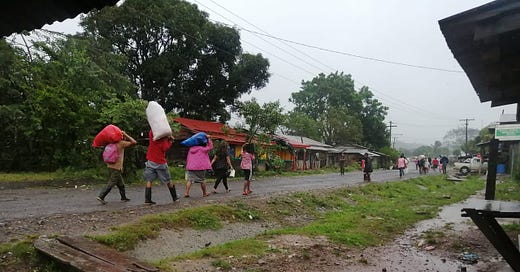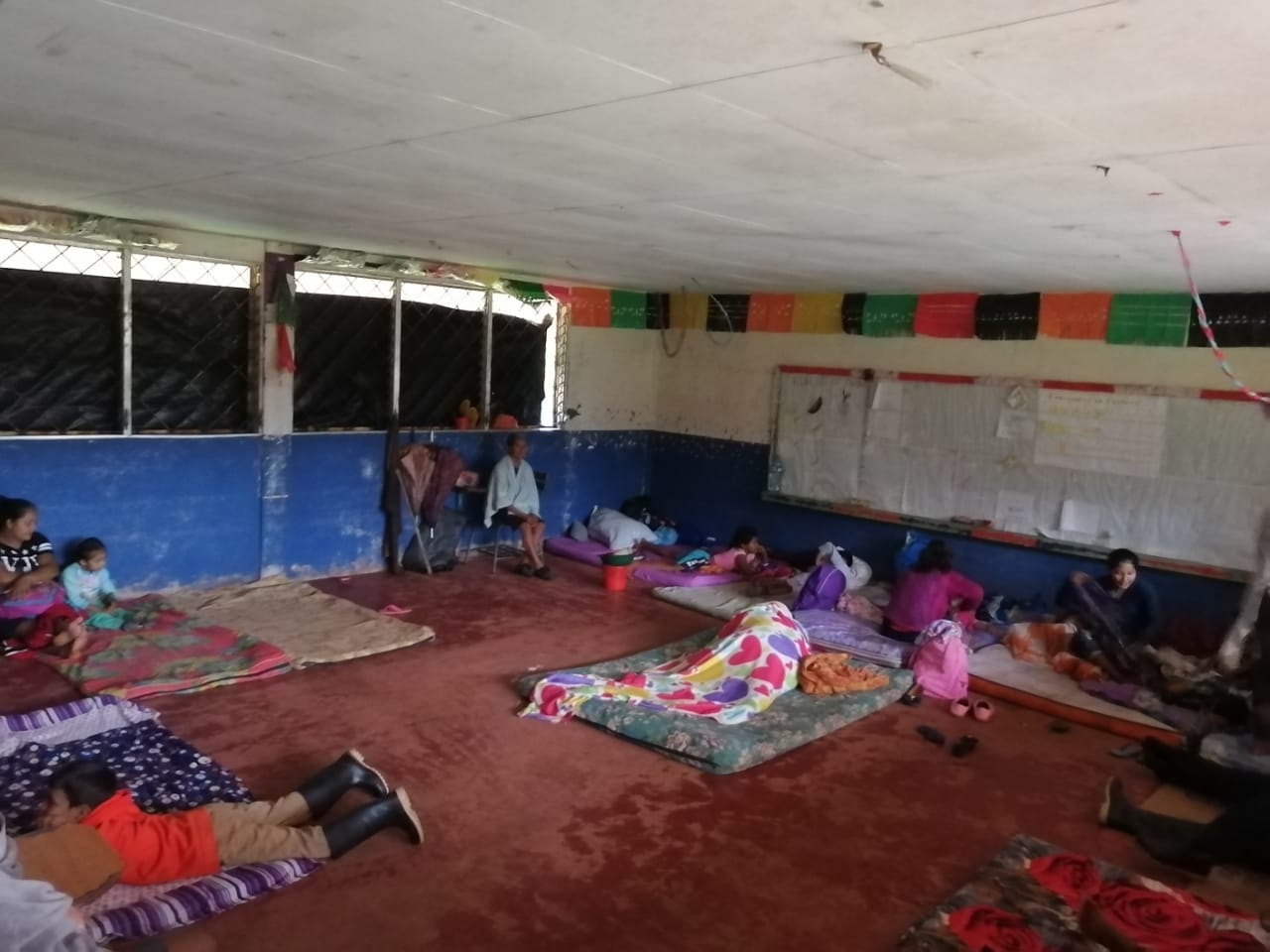Welcome to this latest edition of From a Climate Correspondent. If you'd like to support us, check out our Patreon page, or invite us for a coffee over at KOFI page. Thanks for reading!
Members of the Sahsa community in Bilwi, Nicaragua, leave their homes, uncertain of would happen to them after the passage of Hurricane Eta. Photo by Maynor Salazar.Part 2 of 2. Read part 1 here
By Maynor Salazar in Bilwi, Nicaragua. Translated from Spanish by Jocelyn Timperley.
This article continues the story of Maynor Salazar’s journey to visit communities impacted by Hurricane Eta, which hit Nicaragua two weeks ago. As we publish it, a second major storm, Hurricane Iota, continued to barrel through Nicaragua and other Central American countries.
Our last night in Bilwi, in the northeast of Nicaragua, we spent in the town of Okonwas.
We were unable to advance towards Rosita, a city in the North Caribbean also impacted by Hurricane Eta, because the rising river flooded the only exit route. Hurricane Iota, the storm which entered Nicaraguan territory in the same area this past Monday, just two weeks after Eta and with an even higher intensity, is thought o be causing even worse impacts in the same area.
Our original idea for the next stage of our reporting trip on Hurricane Eta had been to go to Rosita, another impacted area, but a flooded river stopped us from going further. In the evening, lacking baths and completely exhausted, we decided to ask the community members of the area to host us. This proved complicated because the community was distrustful of us, but in the end a pastor helped us.
It had been three days since Eta had hit and she was still within national borders. Eta had lost strength, but the winds and rain did not stop. At Okonwas we were all afraid, the community members, the stranded truck drivers and the journalists who had come into the area. But while everything seemed to indicate destruction could be imminent, the damage was ultimately minimal.
Trapped
Okonwas is located 10 kilometers southeast of the town of Rosita, but from Tuesday to Wednesday morning the road to get there was closed. A motorway under construction means they had just started moving earth to prepare it before the road was to be built, cutting off the community’s communication.
Neither the driver of the largest truck nor the driver of the most "equipped" van dared to cross the huge pool of water that formed in the middle of the road. They all backed off and preferred to wait, some in their vehicles, others in the houses which offered some spaces to host locals and foreigners.
Okonwas community members try to cross a road flooded by the rising River Okonwas. Photo by Maynor Salazar.We all waited for the next day. Sleeping in an area affected by a hurricane raises several questions. The first, without a doubt, is the anguish of believing that the worst could still happen. The houses in this area are not made of concrete: most are made of wood and while their structures can seem solid, they can succumb to gusts of hurricane-force winds. Add to that the fact that many are over ten years old, and the risk increases.
After the uncertainty of risk and destruction, there was insomnia. You cannot sleep when the wind raises the roof or enters through the spaces in wooden beams. Those cracks also gave way to a cold which increased through the night.
The community, owners of the houses, did not seem to be scared by the whole scene: perhaps that is why most decided to stay at home. "It was worse with Felix. By now you had the water up high, you couldn’t see the floor," said the owner of a house serving as refuge for several foreigners.
The other side of the water
The wind had not stopped blowing by early morning, but the rain had subsided. Here in the shelter there was no electricity or battery-powered radio, and the phone signal was unstable. People guessed that Eta was moving away because the gusts of wind became less and less intense, and the breeze became light, similar to good morning just when you realise it will be a good day.
At around 6am, many of the vehicles again approached the huge pool on the road. Its level had decreased, but still none ventured to cross it. "An ambulance went by, but it was one of the big ones. It wasn’t inundated at that level of depth," explained a driver who had arrived minutes before.
As the hours passed, the level dropped bit by bit. First, a community member who came from another area to visit some friends in Okonwas crossed. Next, a young man on his horse passed by. Despite the falling water level, there was still concern. Finally an Isuzu truck advanced, then a big pickup truck, followed by two more vehicles.
More to come
Nicaragua has been one of the countries most impacted by extreme weather events over the past few decades, especially due to the major impact of Hurricane Mitch in 1998. As this article goes to print, another storm, Hurricane Iota, had just hit Nicaragua at Category 4 strength in the same area of the country which had just been impacted by Hurricane Eta.
Residents of the El Naranjal community, in Bilwi, were evacuated to shelter in a school in the town. They asked for medicine and food which was rapidly running out. Photo by Maynor Salazar.The double impact has left indigenous communities with no time to recover. The villagers had to leave their houses, again, in search of a refuge. This time the government was better prepared, but the aid has reportedly still not arrived due to the speed with which Iota reached the North Caribbean.
Although the water level dropped considerably, people in the community were not very enthusiastic. The lack of joy was due to the fact that with this weather and the storm, it was likely that in the next few hours the floods would arrive again.
We finally managed to pass through the water, leaving Okonwas behind and deciding to return to the capital. Fortunately for us, our team returned home safe and sound, but the same cannot be said for those who lost their homes in Bilwi. Eta had left havoc, with more than 30,000 people evacuated from their homes and many houses left damaged.
The outlook for indigenous communities in the North Caribbean is grim. Hurricane Iota will cause more damage than Eta and recovery will be slower. By Tuesday the government said it had evacuated 40,000 people, with many homes already destroyed or flooded. And as if that isn’t enough, there is a chance yet another storm could form in the next few days and impact the Nicaraguan coast again.
Maynor Salazar is a Nicaraguan investigative journalist who writes for Divergentes.com. He has written for international media such as Univision, the Connectas platform and various national media. Find him on Twitter @Maynorsalaz.
This post was funded by climate investigation grant awarded to From A Climate Correspondent by the European Federation for Science Journalism (EFSJ) and funded by the BNP Paribas Foundation.
If you’d like to support us to publish more journalism from the front lines of climate change, please consider supporting us with a regular donation on Patreon or inviting us for a one-time coffee over at KOFI. You can also support use by signing up and sharing this article with others!
Must reads from the region
Dangerous Hurricane Iota Sets Late-Season Records, Lynn Jenner, NASA blogs
Iota is the strongest hurricane and 30th named storm of the 2020 Atlantic season, the highest since modern record keeping began breaking the previous record of 28. It also marked the first time that two hurricanes have formed in the Atlantic in any November.
REDD+ carbon and deforestation cuts in Amazon overestimated: Study, Peter Yeung, Mongabay
Researchers found that the projects’ claimed reductions in forest loss and carbon emissions were seriously overstated due to poorly set deforestation rate baselines.
Mexico explains decision to flood poor, Indigenous areas, Associated Press
Mexican President Andrés Manuel López Obrador chose to direct excess water to poorer, more sparsely populated Indigenous areas, rather than allow a big city to be flooded. “It hurts me a lot,” he said, noting more people would have been affected in the latter case
What else I’m reading
The climatic situation Nicaragua is going through reminds me of several stories by Alice Munro, winner of the Nobel Prize for literature, published in a compilation called “Friend of My Youth”. Not precisely because those stories refer to hurricanes, but because they recreate the mysteries at the center of the human experience. This stormy season will bring with it a lot of experience, but also a lot of stories that will probably never be told or compiled in a good book.
Who we are
From A Climate Correspondent is a weekly newsletter run by four journalists exploring the climate crisis from around the globe. We regularly also feature guest writers.
Lou Del Bello is an energy and climate journalist based in Delhi, India.
Jocelyn Timperley is a climate journalist based in San José, Costa Rica.
India Bourke is an environment journalist based in London, UK.
Mat Hope is investigative journalist based in Nairobi, Kenya.
Been forwarded this email?
Did someone send this on to you? Why not sign up yourself!





